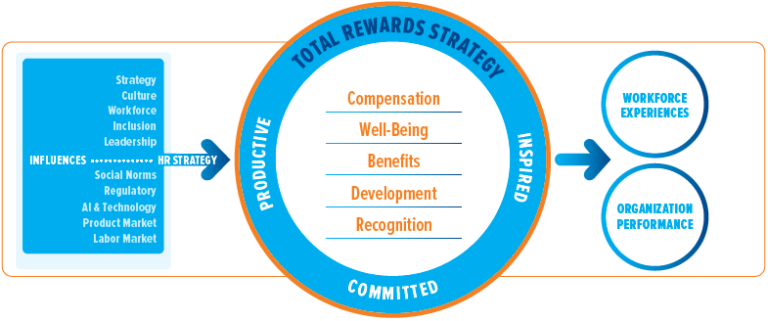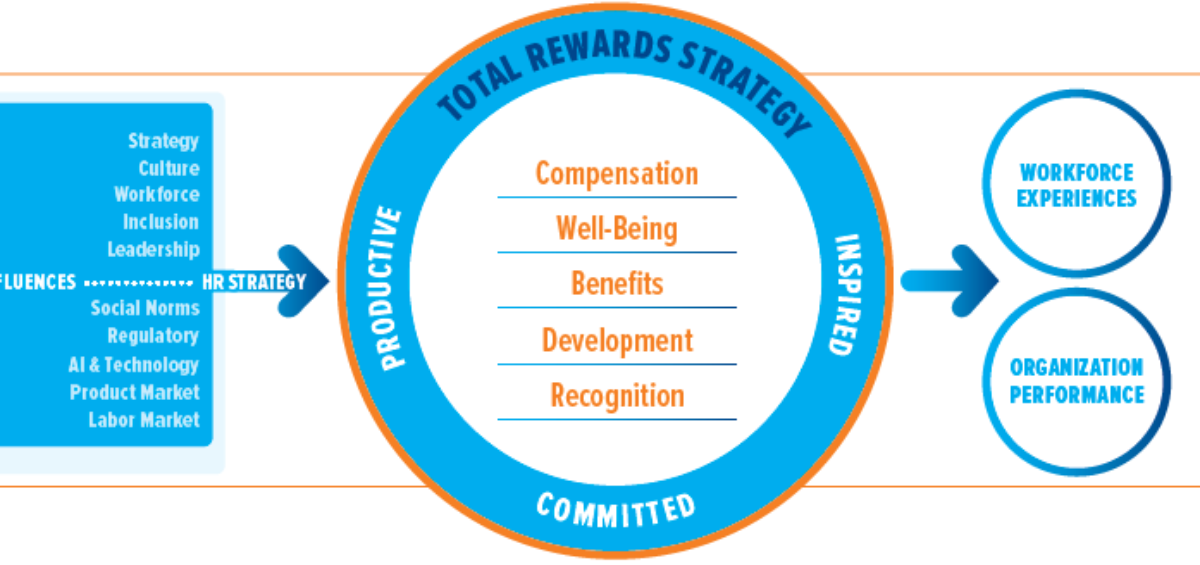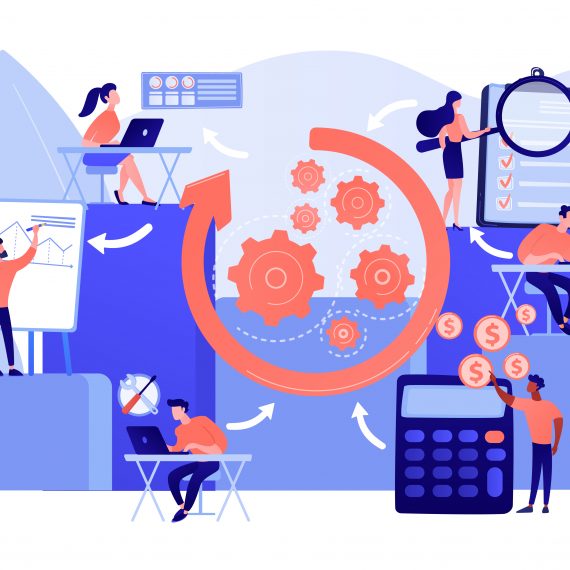When COVID shifted our world in 2020, everyone and every business have been affected. For many, it meant new opportunities and they excelled, for most, it meant their comfort zone shifted and a new normal needed to be created. A new normal that requires new innovative ideas to survive, or you are left behind.
Total Rewards programmes support a company’s ability to stay competitive, increase employee retention and attract talent. Reward professionals are fronting these changes with innovative solutions that not only benefit their employer but can contribute to the greater Reward Profession when these solutions are shared in networks and at events and conferences. There are many Total Rewards Models and this is the WorldatWork Total Rewards Model:

Organisations thrive when their Total Rewards strategy keeps up with the changing internal and external environments. A shift in these environments requires companies to proactively investigate, explore, pivot, shift the people strategies, which are integrated elements of Total Rewards. The Total Rewards strategy does not exist in a silo, it integrates all HR strategies and plays a leading role in the employee experience and employee value proposition (EVP).
Compensation/Remuneration – in the wake of COVID pay freezes and pay cuts were imminent and many companies did not have the budget to align their salaries to the market. What changes are you going to implement to ensure you are still able to attract and retain talent? How are you managing salary expectations amid the war for scarce skills? Are you considering market premiums for critical or high flight risk roles? Are you considering one-off retention or attraction bonuses? Are you considering moving towards skill-based pay? Are you shifting the focus away from salaries to focus on other elements of Total Rewards? If your variable pay and incentive programmes still fit-for-purpose and driving the right behaviours? Some employees would settle for smaller compensation just so they can work remotely.
Wellbeing– flexible working arrangements may perhaps have been your competitive advantage for attracting talent before 2020. Now it is a core benefit at many companies and has become a desired wellbeing and work-life balance benefit. Surprisingly many companies changed back to an office-based approach when they could, with limited opportunity to work from home or they may have a one-size-fits-all approach to avoid tough non-performance discussions. Employee wellbeing benefits that include free vaccinations, financial and mental wellbeing training, gym memberships, health insurance, healthy meals/Cafeteria options, on-site health checks, wellbeing seminars and fairs, on-site massage, subsidised insurances, scholarships/student loans, funeral benefits, income protection, etc can reduce absenteeism and increase productivity and employee engagement.
Benefits – Do you survey your employees to know what benefits appeal to which category of employee? Do you maximise the offering of your own services at a reduced rate to employees? Do you provide community involvement opportunities during working hours as part of your social corporate responsibility? Do you offer unique benefits that may give you a competitive advantage to attract talent and is that included in your talent acquisition strategy? Do you provide “varying for dependents benefits for example on-site or subsidised childcare, caregiver support, etc? Doing a market benchmarking on benefits will give you insights into how you compare to the market and what other benefits are offered in the market. This information should be weighed against what your employees want before you consider changing it, so you have the desired return on investment.
Development and advancement opportunities – Investing in training and development opportunities can give you a competitive advantage, even when your salaries are not competitive. Are you negotiating creative partnerships with training institutions to offer practical experience to their students in return for lower training fees for all your employees? This arrangement may attract Fringe Benefit Tax (FBT) under specific conditions though, which you need to consider. Did you consider developing training and development programmes for the wider community where there is an opportunity to commercialising your training department to generate revenue and at the same time delivering the training to your own staff (corporate universities)? How do you ensure your employees receive new technology training? Do you offer formal coaching and mentoring programmes? Do you offer job rotations/secondment opportunities as part of their development? Do you provide equal opportunity recruitment and commitment to first consider your employees before sourcing externally? Do you have succession plans and career development discussions with employees so they know they have a future and can grow within the company?
Recognition – Recognition programmes is an investment, not an expense. It increases employee motivation, productivity, retention and employee engagement. Effective recognition programmes can be your competitive advantage if well designed and promoted and when salaries are under pressure. If staff feels appreciated, inspired and rewarded for their contribution it can elevate performance with exceptional results for the organisation. This includes monetary and non-monetary recognition. You can keep this cost internally by issuing gift vouchers for services or products that your company own/offer. Have you considered alternatives to bonus payments such as time-off, which should not affect your leave liability if managed on a use-or-lose basis for a specific period. Don’t underestimate the power of peer-to-peer recognition.
Internal Influences- Strategy, culture, workforce, diversity and inclusion and leadership are all affecting your strategic Total Rewards. During COVID companies had to adjust and align to changing circumstances with budget limitations and a refreshed company strategy to survive.
As your workforce demographics change, your Total Rewards should be adjusted to cater for their diverse needs. Your Total Rewards strategy is also influenced by new skills requirements and a need for more flexible work arrangements. Your diversity and inclusion strategies can give you a competitive advantage to attract and retain scarce skills.
It is important that you have the right leadership capabilities to drive success through your Total Rewards strategies. Leaders play an active role in explaining Total Rewards and related initiatives to their teams. Continuously review your Total Rewards to ensure it is well-understood, used and appreciated by employees to yield the right results. Communication must clearly outline what has changed, what the new expectations are, how efforts will be aligned to motivate the behaviours required to deliver new results in the new normal.
External influences- The continuous shift in social norms, regulatory environment, technology advancement, labour market requires you to review your Total Rewards programmes and strategies to attract and retain the right talent for the future. The border closure that resulted in a war for skills has affected many companies and required them to relook their Total Rewards strategy to attract and retain talent and to develop internal skills to be fit for current and future needs.
It is important to validate and measure the access, utilisation and success of your Total Rewards offering. This can be done through engagement surveys and tracking benefit utilisation, retention, absenteeism, talent attraction (why they came to work for your company?).
Your Total Rewards should be flexible and should consider employees’ unique needs during different life stages (My-Pay-My-Way). Maximise your Total Rewards through technology that creates awareness and gives easy access to staff. When fully aligned to your company strategy and to what employees want, your Total Rewards strategy can help you transform and reinforce the desired culture and influence how work is performed and recognised. It encompasses the total value proposition to an employee and integrates all people strategies.





Leave a Comment